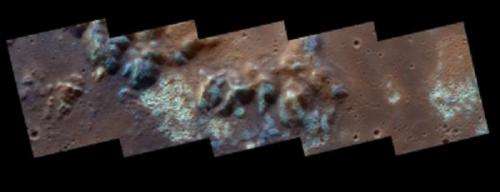New features discovered on Mercury could be evidence of hydrogen geysers and metallic iron

How long has it been since you’ve taken a good look at Mercury? For the backyard astronomer, all we’ll ever see is the speedy little planet as a bright crescent a few times a year. But, for the MESSENGER spacecraft, Mercury isn’t quite as boring as you might think! Some strange new features have been spotted and a planetary geologist speculates they could be attributed to hydrogen venting from the planet’s interior.
While it’s only been a week since MESSENGER sent back some curious photos of Mercury’s surface, the revelation has created quite a stir in the planetary science community. These observations have included evidence of shallow depressions which have formed into non-uniform crater structures which appear to be recent. In addition, they have a high albedo – indicative of some sort of reflective material. But, what?
According to Marvin Herndon, an independent scientist based in San Diego, Mercury formed under great pressure and high temperature – enough to leave iron in a molten state. If so, it should be responsible for absorbing large amounts of hydrogen. As it cools and transforms to a solid state, the hydrogen is then released, forming a type of “geyser” on the planet’s surface.
“These hydrogen geysers could certainly have caused the rimless depressions that MESSENGER sees.” says Herndon, a self-proclaimed maverick in the world of planetary geology.
As the hydrogen is released from below the planet’s surface, it would also react with other elements it would encounter – possibly iron sulphide, commonly found on Mercury’s surface. This would cause a reduction to metallic iron. From there it would form a light “dust” which could account for the bright, new features seen by MESSENGER.
More information: Explanation for Observed Evidence of Geologically Recent Volatile-Related Activity on Mercury's Surface, arXiv:1110.5796v1 [physics.gen-ph]
Abstract
High resolution images of Mercury's surface, from the MESSENGER spacecraft, reveal many bright deposits associated with irregular, shallow, rimless depressions whose origins were attributed to volatile-related activity, but absent information on the nature and origin of that volatile matter. Here I describe planetary formation, unlike the cited models, and show that primordial condensation from an atmosphere of solar composition at pressures of one atmosphere or above will lead to iron condensing as a liquid and dissolving copious amounts of hydrogen, which is subsequently released as Mercury's core solidifies and escapes from the surface, yielding the observed pit-like features with associated highly-reflecting matter. The exiting hydrogen chemically reduces some iron compound, probably iron sulfide, to the metal, which accounts for the bright deposits.
Source:




















